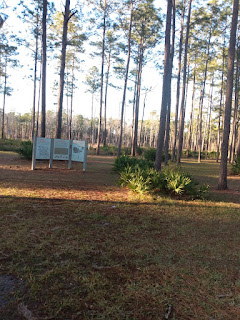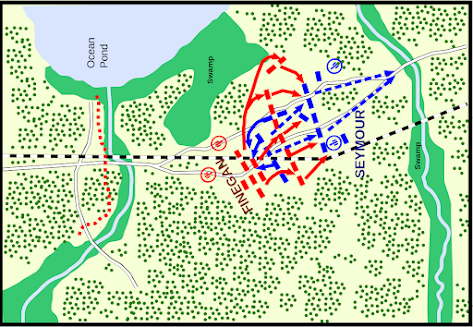 |
| In the canyon |
Two and a half years ago, well into the Plague, my wife, the luminous Mrs. V, decided a short invitation to stay at someone's place in St. Augustine should be turned into the first leg of a massive road trip. We were both out of work with no clear indication of when we'd resume. It might be our only chance for a long time to take such an undertaking.
The original plan was to drive to St. Augustine, then drive west to the Grand Canyon. Coming back, we'd swing a little further north and hit a string of Civil War sites and the Laura and Almanzo Wilder house in Mansfield, Missouri (Mrs. V is a huge fan. We've been to Mansfield before and it was something to see her and several other women almost in tears the first time they realized they were standing on the same linoleum Almanzo had put down and Laura had walked on).
As soon as we hit St. Augustine, our plans fell apart. An ice storm had devastated Texas, knocking out the power grid across much of the state. Driving overland through Texas in the midst of that disaster was not going to happen. This was also pre-vaccine, so some states were still being obnoxious towards out-of-towners.
Mrs. V quickly came up with an alternate plan. First, we'd fly out to Phoenix and then drive up to the Grand Canyon. After flying back to St. Augustine, we'd drive west through Mississippi and Arkansas, loop back eastward at Mansfield, and come home thru Tennessee and West Virginia. It's what we did, and it was the best and longest road trip we've ever taken.
After a few days in St. Augustine, we flew out of Jacksonville. With masks on the entire flight, it was only slightly uncomfortable. It was pre-vaccine so many people were still overly nervous and the airlines were being hardcore to make . The flight was short and sweet and the view of Galveston and the rest of Texas from the air was fascinating. What we saw of Phoenix was soulless and desiccated. Lots of new buildings and dreary old concrete ones on great, wide, empty streets.
The drive up to Grand Canyon Village was very nice. I'm not sure I'd ever realized how striking ochre and beige landscape could be. Flagstaff was mostly hotels, motels, and shopping plazas, but most of the drive was through largely unblemished plains and rocky escarpments. The horizon seemed further than it had ever seemed before and the February sky was a shocking azure.
We finally arrived at the Grand Canyon at dusk. We weren't sure where our hotel was, so we pulled into the first parking lot we encountered. I stepped out of the car and wondered where exactly the canyon was. Suddenly, as I turned around and my eyes adjusted to the evening's light, I realized it was fifteen feet beyond the front of our car. If you haven't seen it, imagine something carved jaggedly into the Earth's crust over ten miles across. Its walls are an array of colored layers, stretching out for miles and miles in both directions. Looking over the parking lot wall, we could just make out the bottom, thousands of feet below, in the fading light.
Now, I am not a hiker and I especially don't like hiking up elevations. Mrs. V's plan, though, had us hiking way down the canyon, twelve or thirteen miles along the floor, then back up. To say I was dubious of this plan is insufficient. My brain was shouting repeatedly that this was insane. Nonetheless, I acquiesced, out of love and out of one of my occasional flashes of a "why the heck not?" attitude.
To prepare a little, the next day we drove down to Sedona where we intended to take a hike onto and around a butte. It was a beautiful day and away from the touristy main part of Sedona, the land was beautiful, too. To be honest, it reminded me of some of the rides from Knotts Berry Farm I took when I was a little kid - and that was very cool.
Rising out of the side of the butte is the
Chapel of the Holy Cross. Built in 1954, the chapel was commissioned by rancher/sculptor Marguerite Brunswig Staude. It wasn't open to visitors that day, but the parking lot was. The only thing was, at 5:00 the lot was going to be locked and our car would be trapped if we hadn't returned by then. We had two and a half hours, though, so we were sure we could make it around and back in time. Ha!
The hike was unpleasant, Mrs. V got us off the often poorly-marked trails and lost two or three times. Fortunately, we managed to get back on track each time, but the clock was counting down.
The views from the trail are impressive. I don't know how high up we were, but you could see all of Sedona and the surrounding mountains. We stopped several times to just look at the world moving below us. And the clock continued to tick.
During one of the periods of being lost, I told Mrs. V something I considered very important. I, from the bottom of my heart, from the depths of my soul, hated what we were doing. Despite the beauty of the butte, despite the wonderful views, I hated the hike. I hate all hikes. I do not and will not enjoy them. But, and this was important, I will do them because you want to.
I move slowly going uphill; it's just a fact of life. Years ago, hiking across Devon, Mrs. V would be hundreds of feet ahead of me as we climbed roads that felt damn near vertical. The same happened here. Increasingly, even as we knew we were near the end, it felt like we wouldn't make. With about fifteen minutes to go, she decided to take off and leave me behind. She made it, secured our car, and I wandered in about ten minutes later. It had been a near-run thing.
After the day's adventure, Mrs. V willingly cut down her ambitions for the Grand Canyon. We'd only go down to the bottom and then hike back up, a much more reasonable distance. We'd get up early, around six thirty, eat, then head off to the trailhead and begin our descent by seven thirty, or so.
 |
| No proof against the cold |
When we woke up it was freezing. It had been comfortable when we arrived at the Canyon, but it was late February and it gets cold out there. It was below freezing, ice had formed on the trails, and we had nothing remotely adequate to wear as you can see.
We decided to hold off until it warmed up and do what we could do. In the end, we hiked about four miles from the Kachina Lodge along the South Rim to the South Kaibab Trail, ravens racing and swooping overhead. Once there, we hiked down the switchback trail along the Canyon wall about a mile and a half down and then back up again.
 |
| Switchback |
The amazing engineering feat of the trail, the stunning vistas it afforded us, the quiet, only occasionally broken by bird calls, and the very cool mule trains we had to step aside for several times, almost made me like hiking.
 |
| Mules looking askance |
Actually, I did love the hike. There are many wonderful natural places in America and I've been lucky enough to see some of them - the coast of Kauai, Glacier National Park, the Adirondacks - but I had never been to the Grand Canyon before. If you ever have the chance, go.
From that first view from the parking lot to the last glimpse as we drove away, I remained stunned by the immensity and beauty of the place. None of my pictures do the least justice to those qualities, but here are a few for some sense of the place.
We left the Grand Canyon, drove back to Phoenix, and then flew to Jacksonville. After a few more days in St. Augustine, we hit the road for the third, and longest leg, of our trip.






































